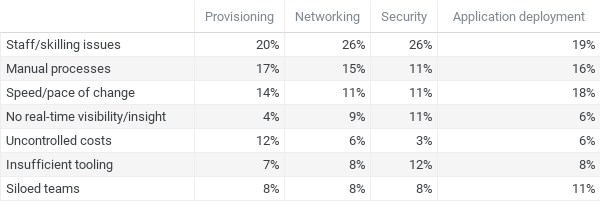HashiCorp Posts Multi-Cloud Survey Results

HashiCorp has released results of a State of Cloud Strategy Survey of 3,205 technology decision-makers and practitioners, highlighting obstacles in the path of a general migration to multi-cloud environments.
HashiCorp, whose software includes commercial implementations of open-source configuration, provisioning, zero-trust security, and cloud management tools, conducted the highly detailed survey in February 2021 among respondents from companies of all sizes and geographies worldwide.
Results indicate that 76% of those surveyed have adopted a multi-cloud strategy, though a large portion are struggling with making it work as well as they’d like. For example, 90% of businesses with more than 5,000 employees have adopted multi-cloud, but 64% of large-enterprise respondents said multi-cloud has helped achieve their business goals, as shown in the tables below:
Source: HashiCorp State of Cloud Strategy Survey
Multi-Cloud Momentum Reported
Respondents report that the move to multi-cloud has been driven by a goal of digital transformation (34%), avoiding single-vendor lock-in (30%), cost reduction (28%), and the need to scale (25%), among other factors.
These results tally with an earlier Futuriom survey, in which respondents repeatedly cited consolidation of multi-cloud and hybrid cloud as a goal for cost reduction and governance.
A move to multi-cloud is aided by other technologies, including infrastructure as code, application delivery automation, container orchestration, and secrets management. Over half of respondents plan to have all of these completely adopted in their networks within one year.
Open-source Software Preferred
Not surprisingly, AWS remains the top public cloud vendor of choice among 88% of respondents, a number that’s reflected in general market figures. That percentage isn’t expected to change over the next two years. But use of Microsoft Azure (reported by 74%) and Google Cloud Platform (61%) is expected to grow to 77% and 64% respectively.
When it comes to tools for automating multi-cloud functions, open-source software is preferred, either for in-house development or as a service, by over 50% of respondents: For provisioning, 67% said they preferred open source; for networking, 58%; for application deployment, 61%. The exception is security, where 48% think open source is the way to go, while 42% opt for commercial products or services. Ten percent think creating their own security products from scratch is preferable.
The most popular tools and technologies for multi-cloud environments include HashiCorp’s Terraform (which is based on an open-source provisioning and orchestration platform); Kubernetes containerization; and the Github development platform.
Cloud Skills Shortages Cited
Several obstacles were cited by respondents as hindrances to their cloud programs. Cost concerns (reported by 51%) and security concerns (ticked by 47%) topped the list. But lack of in-house skills was reported by 41% as a key obstacle. Skills shortages also were first on the list of challenges hindering organizations’ ability to operationalize multi-cloud environments; this item was checked off by 57% of respondents.
Indeed, a lack of skills was the top challenge for each component of cloud efforts, as shown in the chart below, which is a partial list of challenges gathered by HashiCorp:

Source: HashiCorp State of Cloud Strategy Survey
Despite the obstacles, the survey reveals the growing popularity of the multi-cloud approach. Within two years, 86% of respondents, nearly 9 out of 10, expect to have adopted multi-cloud as their business environment.
"Multi-cloud adoption is important for us," one respondent is quoted as saying. "It allows us to experiment with emerging technologies that [are] only available at certain providers while running the main load at the other provider."
The survey in its entirety can be found here.



















